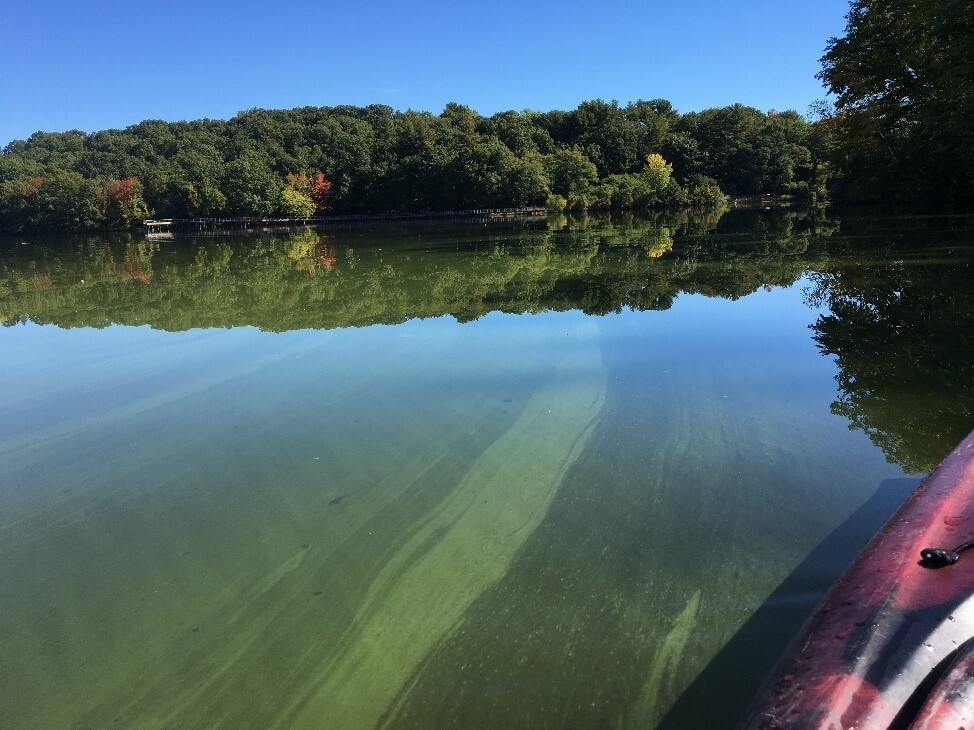Do you like to swim? Fish? Kayak? Bird watch? Picnic on the beach? You can do all of this and more right here in Worcester! Despite being the second largest city in New England, Worcester is a hidden gem for aquatic recreation. Today, we’re highlighting the Lakes & Ponds Program, which monitors, manages, and promotes Worcester’s recreational water bodies or “blue spaces”.
Worcester has more than 20 lakes and ponds, including 17 publicly accessible waterbodies! The City recognizes our blue spaces as valuable resources and strives to maintain the quality of these waters for recreational use and the promotion of economic development.
The Lakes & Ponds Program has three main functions:
1. Monitoring and testing for environmental threats

A blue-green algae bloom at Coes Reservoir
Although Worcester is home to many beautiful blue spaces, effects of the urban environment can make them harder to enjoy. Cyanobacteria (blue-green algae) blooms can produce toxins that can be harmful to humans and their pets. E. coli bacteria can close beaches to swimming and make you sick. Invasive aquatic plants can crowd out ecosystems and make waterways less attractive and safe for recreation. The Lakes & Ponds Program directly monitors these issues and their root causes and uses these data to inform management solutions. Lakes and Ponds staff are consistently out on waterbodies collecting data to help understand water quality challenges and inform their solutions. L&P is also able to work with many enthusiastic community partners to increase our reach and monitor more waterbodies.
L&P facilitates the Worcester Cyanobacteria Monitoring Collaborative (WCMC), a dedicated group of over 50 volunteer community scientists that collect samples at 26 local waterbodies to determine the risk of cyanobacteria blooms.


Nick Pagan, our Environmental Analyst conducting water quality testing on Lake Quinsigamond
A Community Scientist with the Worcester Cyanobacteria Monitoring Collaborative collecting samples to determine cyanobacteria bloom risk
2. Managing our local water bodies
The Lakes and Ponds Program actively manage threats to public health and aquatic recreation such as harmful cyanobacteria blooms, invasive aquatic plants, and beach closures due to E. coli bacteria.
Recently, the Lakes & Ponds program has taken an innovative approach to managing cyanobacteria at Indian Lake. Rather than directly treating cyanobacteria populations in the lake, L&P moved toward addressing the root cause: nutrient pollution. In 2023, the City completed the installation of a state-of-the-art dosing station on the lake’s primary tributary that stops excess nutrients as they enter the lake. This station is only the second to be built in the state!
3. Engaging the community

Given Worcester’s fantastic aquatic resources, our lakes and ponds naturally have many champions. L&P aims to engage with everyday users of Worcester’s waterbodies ranging from residents that like to swim at our public beaches to members of local lake and watershed associations. Through our outreach activities we strive to understand the concerns of lake users, communicate about threats to our ecosystems, partner with community groups to achieve shared goals, foster a new generation of water quality advocates, and share enthusiasm about our resources to promote our fantastic recreational opportunities.
This map shows activities and amenities that are available at each of Worcester's public water bodies. These include activities like swimming and boating, and amenities like parking and accessibility features. View the interactive map here -- it makes it easier than ever to find out where you can enjoy your favorite water activities right in the City!

Interested in supporting watershed protection in Worcester?
Excellent! There are many ways to get involved.
- Sign up for the Worcester Cyanobacteria Monitoring Collaborative and become a community scientist!
- Use the Boats Decontamination Stations
- Watch a Blue Space Minute video on the stations
- Sign up for lake closure text alerts
Lastly, make sure to catch this year’s State of the Lakes Presentation on March 14th, which showcases Lake & Pond Program achievements, along with the latest on water quality, upcoming improvement projects, and more ways residents can get involved. Keep an eye out on the Lakes & Ponds page for the event signup link.

Bell Pond on a sunny day.
Previous Post
Energy Efficiency
Next Post
Home Heating Tips for Renters



